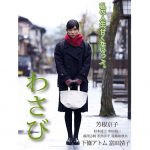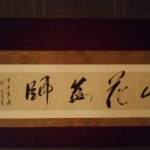WIT Life #318: Shuji Terayama
Written by professional Writer/Interpreter/Translator Stacy Smith (Kumamoto-ken CIR, 2000-03), WIT Life is a periodic series about aspects of Japanese culture such as film, food and language. Stacy starts her day by watching Fujisankei’s newscast in Japanese, and here she shares some interesting tidbits and trends along with her own observations.
Last week I had the opportunity to see some amazing works from legendary avant garde Japanese poet, dramatist, writer, film director, and photographer Shuji Terayama. I hadn’t heard of him before, but many critics view him as one of the most productive and provocative creative artists to come out of Japan. He has also been cited as an influence on various Japanese filmmakers from the 1970s onward. The three films screened were Americans, who are you (アメリカ人あなたは), Laura (ローラ) and The Trial (審判).
A special treat was that Laura included the restaging of Terayama’s 1974 film performance with the original actor, Henrikku Morisaki, who was in attendance. This short film feature female strippers who are berating the audience, when all of a sudden a spectator (Morisaki) enters the film. We saw scenes of him as a young man in this role, being stripped and assaulted by the women. At the end of the film he emerged from behind the screen, this time naked and holding his torn clothes. In an interview post-screening, Morisaki told stories about his work with Terayama over the course of almost 17 years. He described Read More
WIT Life #316: Frank Lloyd Wright’s Teikoku Hotel
Written by professional Writer/Interpreter/Translator Stacy Smith (Kumamoto-ken CIR, 2000-03), WIT Life is a periodic series about aspects of Japanese culture such as film, food and language. Stacy starts her day by watching Fujisankei’s newscast in Japanese, and here she shares some interesting tidbits and trends along with her own observations.
This year marks the 150th anniversary of Frank Lloyd Wright’s birth, and celebrations are taking place around the country and world. I recently had the chance to go to MoMA’s Frank Lloyd Wright at 150: Unpacking the Archive (ending October 1 so run to check it out if you haven’t already!). This incredibly comprehensive exhibit looks at Wright’s career from 12 different perspectives, each of which has its own section. There are around 450 works that he made from the 1890s through the 1950s on display, and each section has a video narrated by a scholar in the respective field.
I was particular interested in the section discussing the second version of the Imperial Hotel (帝国ホテル), designed by Wright and built from 1919–1923). It survived the Great Tokyo Earthquake that September, but eventually slipped into decay over time and in 1967 it was decided to demolish the hotel and replace it with a high-rise building. The structure was mostly destroyed, but the iconic central lobby wing and reflecting pool were disassembled and rebuilt at Meiji-mura in Nagoya, which I was lucky enough to visit during a recent business trip.
This is an amazing theme park with a variety of architecture mostly from the Meiji Era (1868-1912), and Read More
WIT Life #315: Kew Gardens Festival of Cinema
Written by professional Writer/Interpreter/Translator Stacy Smith (Kumamoto-ken CIR, 2000-03), WIT Life is a periodic series about aspects of Japanese culture such as film, food and language. Stacy starts her day by watching Fujisankei’s newscast in Japanese, and here she shares some interesting tidbits and trends along with her own observations.
Last week the inaugural Kew Gardens Festival of Cinema began, and I’ve had the chance to catch a lot of great films at the two main venues of Kew Gardens Cinema and Queens Museum. Today they screened Persona Non Grata (杉原千畝 スギハラチウネ, 2015), a film about Japanese diplomat Chiune Sugihara (“Japanese Schindler”) who served as a consul in Lithuania from 1939-40 and saved the lives of thousands of Jewish refugees by issuing over 2000 transit visas to Japan. He famously continuing to sign visas even as his train pulled away from the station, and is estimated to have saved over 6,000 lives from the Nazis who invaded Lithuania in 1941. However, his diplomatic career was ruined because he had defied instructions from the Ministry of Foreign Affairs not to issue the visas. Sugihara didn’t know if they had made any difference until being found years later by someone he had helped. He is now considered a hero in Japan, and those he saved have more than 40,000 descendants.
The film stars the phenomenal Toshiaki Karasawa as Sugihara and the always stellar Read More
WIT Life #314: New York Asian Film Festival (NYAFF) 2017
Written by professional Writer/Interpreter/Translator Stacy Smith (Kumamoto-ken CIR, 2000-03), WIT Life is a periodic series about aspects of Japanese culture such as film, food and language. Stacy starts her day by watching Fujisankei’s newscast in Japanese, and here she shares some interesting tidbits and trends along with her own observations.
This weekend concludes the 2017 New York Asian Film Festival (NYAFF), which offered another amazing lineup of films and special guests. This is the 16th year of its running, and it just seems to get better over time. I saw two of the Japanese films screened at Lincoln Center’s Walter Reade Theater, the festival’s venue, and another two I had seen on the plane during a recent business trip to Japan (In this same venue the week before the event I had the chance to see Harmonium (淵に立つ), which was not part of the festival but is another thought-provoking and upsetting Japanese film).
The two film s I saw at the festival were Rage (怒り) and Double Life (二重生活). Rage stayed with me for a while after watching it; it is not a film you can easily shake. It is based on the mystery novel of the same name by Shuichi Yoshida, who also wrote Villain and Parade which were both made into fantastic films (the former directed by Sang-il Lee, who made Rage). The story begins with the heinous murder of a couple in their home, with the young, male killer on the loose.
s I saw at the festival were Rage (怒り) and Double Life (二重生活). Rage stayed with me for a while after watching it; it is not a film you can easily shake. It is based on the mystery novel of the same name by Shuichi Yoshida, who also wrote Villain and Parade which were both made into fantastic films (the former directed by Sang-il Lee, who made Rage). The story begins with the heinous murder of a couple in their home, with the young, male killer on the loose.
Characters from communities in three different parts of Japan (Chiba, Tokyo and Okinawa) are shaken by the appearance of three respective young men who fit the description of the wanted man. As the manhunt unfolds, the more we find out about each suspect the more the suspense builds. I was on the edge of my seat for the majority of the film, but once this fear dissipated the psychological terror of the Read More
WIT Life #313: NY Japan CineFest 2017
WIT Life is a periodic series written by professional Writer/Interpreter/Translator Stacy Smith (Kumamoto-ken CIR, 2000-03). She starts her day by watching Fujisankei’s newscast in Japanese, and here she shares some of the interesting tidbits and trends along with her own observations.
 Last night I attended the first night of the 6th annual NY Japan CineFest 2017 at Asia Society. This is one of my favorite cinematic events in the city, as it is a compilation of Japan-related short films. As usual, there were many thought-provoking selections ranging from documentary to futuristic to artistic.
Last night I attended the first night of the 6th annual NY Japan CineFest 2017 at Asia Society. This is one of my favorite cinematic events in the city, as it is a compilation of Japan-related short films. As usual, there were many thought-provoking selections ranging from documentary to futuristic to artistic.
My favorite was Wasabi from director Bunji Sotoyama, which stars Kyoko Yoshine who you might recognize as the main character from the recently ended NHK morning drama Beppin-san. In this film, she plays high school student Aoi who lives with her depressed father who is no longer able to maintain his sushi shop. She is Read More
WIT Life #312: The Departure
WIT Life is a periodic series written by professional Writer/Interpreter/Translator Stacy Smith (Kumamoto-ken CIR, 2000-03). She starts her day by watching Fujisankei’s newscast in Japanese, and here she shares some of the interesting tidbits and trends along with her own observations.
Last month’s Tribeca Film Festival featured the world premiere of the documentary The Departure directed by Lana Wilson. It profiles Ittetsu Nemoto, a Buddhist priest whose lifework is suicide prevention. In the group sessions he holds at his temple, he introduces exercises that attempt to show attendees what ending their lives would really mean in terms of loss and even simulates the experience of dying. Many participants come away with a renewed lease on life, and for those who don’t Nemoto makes himself available to them day and night whenever they need someone to talk to.
However, Nemoto’s devoted around-the-clock counseling takes its toll on him, both Read More
WIT Life #311: Premium Friday
WIT Life is a periodic series written by professional Writer/Interpreter/Translator Stacy Smith (Kumamoto-ken CIR, 2000-03). She starts her day by watching Fujisankei’s newscast in Japanese, and here she shares some of the interesting tidbits and trends along with her own observations.
A little over a month ago Japan began a new public-private initiative c alled Premium Friday (aka プレミアムフライデー or プレ金) as part of ongoing labor reform efforts from the government. This monthly event will take place on the last Friday of each month, and its official launch was on February 24th. The idea for Premium Friday was conceived by the Japan Business Federation, and the concept is that employers let their employees leave at 3 p.m. on the final Friday of the month. This is not just an altruistic move the Federation is making on behalf of workers; the goal is to have shorter hours boost productivity and encourage consumer spending. It is also a response to the suicide of a 24-year old employee at Japan’s largest advertisement agency Dentsu in December of 2015, which authorities ruled was a result of overwork.
alled Premium Friday (aka プレミアムフライデー or プレ金) as part of ongoing labor reform efforts from the government. This monthly event will take place on the last Friday of each month, and its official launch was on February 24th. The idea for Premium Friday was conceived by the Japan Business Federation, and the concept is that employers let their employees leave at 3 p.m. on the final Friday of the month. This is not just an altruistic move the Federation is making on behalf of workers; the goal is to have shorter hours boost productivity and encourage consumer spending. It is also a response to the suicide of a 24-year old employee at Japan’s largest advertisement agency Dentsu in December of 2015, which authorities ruled was a result of overwork.
At the start there were 130 companies that actually implemented Premium Friday, and 4000 have applied for the official logo (pictured above). Of those already on board the majority are larger companies, and only 3.7 percent of Tokyo area employees took part in the inaugural event. Statistics for the second Premium Friday which took place today have not been released yet, but considering that March 31 is the end of Japan’s fiscal year and one of its busiest days overall, it it likely that participation was not stellar. For those who took part last month, some of the activities people engaged in were Read More
WIT Life #310: The Beauty of Washi
WIT Life is a periodic series written by professional Writer/Interpreter/Translator Stacy Smith (Kumamoto-ken CIR, 2000-03). She starts her day by watching Fujisankei’s newscast in Japanese, and here she shares some of the interesting tidbits and trends along with her own observations.

One of Suzuki Sensei’s amazing works: 以花為師 (“Life lessons from flowers”). It reads from right to left, but is slightly cut off at start.
This weekend I had a chance to sit in on a culture class at the Nippon Club for the purpose of writing an article in Chopsticks. We were studying calligraphy, but specifically practicing this art on 和紙 (washi or Japanese paper). Sensei Mori Suzuki was visiting from Japan just for this class, and in addition to guest teaching we got to enjoy an exhibition of his work and other washi delights in the 7th floor gallery. Entitled 「和紙・伝統と創造」 (Washi: Dentou and Souzou or “Washi Paper: Cultural Heritage and Artistic Creativity”), this exhibit introduces the history of traditional handmade washi, the aesthetic beauty of 切金(kirikane or metallic foil cut into strips or other shapes to form decorative motifs) through the subtle light reflected from foil, origami artwork, modern washi sculptures, and Suzuki Sensei’s calligraphy creations on handmade washi. It runs through February 24 with free admission, and the gallery is open every day but Sunday so make sure to check it out before it closes !
!
WITLife #309: An Evening of Umami and Shokuiku
WIT Life is a periodic series written by professional Writer/Interpreter/Translator Stacy Smith (Kumamoto-ken CIR, 2000-03). She starts her day by watching Fujisankei’s newscast in Japanese, and here she shares some of the interesting tidbits and trends along with her own obs ervations.
ervations.
Last night I had the opportunity to interpret for Chef Kiyomi Mikuni at an event at Japan Society entitled “Umami and Other Japanese Culinary Secrets.” Mikuni is an entertaining speaker whose wide-ranging presentation covered everything from how important it is to develop taste buds at a young age to working with Japanese children on 食育 (shokuiku, or dietary education). Mikuni runs the gourmet French restaurant Hotel de Mikuni in Tokyo, but his culinary journey started in a fishing village in Hokkaido. Growing up he would go out with his fisherman father, and enjoy the fruits of the sea bestowed upon them. At 15 he went to Sapporo to work as a chef at a hotel there before moving to Tokyo’s Imperial Hotel. At 20 he was sent to Geneva to be the chef at the Japanese Embassy, where he Read More
WIT Life #308: Silence
WIT Life is a periodic series written by professional Writer/Interpreter/Translator Stacy Smith (Kumamoto-ken CIR, 2000-03). She starts her day by watching Fujisankei’s newscast in Japanese, and here she shares some of the interesting tidbits and trends along with her own observations.
Last night I attended a screening of Martin Scorsese’s new film Silence, based on the 1966 novel 沈黙 (Chinmoku) by Shusaku Endo, himself a Japanese Catholic. It is the story of a Jesuit missionary sent to 17th century Japan, who is playe d with great nuance by Andrew Garfield. He and his followers endure horrible persecution during this period when 隠れキリシタン (Kakure Kirishitan or Hidden Christians) are targeted for their beliefs. Having lived in Kyushu I had a vague sense of what had taken place in Nagasaki at that time, but not the extent of the barbaric ways Christians were killed and tortured. Read More
d with great nuance by Andrew Garfield. He and his followers endure horrible persecution during this period when 隠れキリシタン (Kakure Kirishitan or Hidden Christians) are targeted for their beliefs. Having lived in Kyushu I had a vague sense of what had taken place in Nagasaki at that time, but not the extent of the barbaric ways Christians were killed and tortured. Read More
WIT Life #307: The Wonderful World of Shochu
WIT Life is a periodic series written by professional Writer/Interpreter/Translator Stacy Smith (Kumamoto-ken CIR, 2000-03). She starts her day by watching Fujisankei’s newscast in Japanese, and here she shares some of the interesting tidbits and trends along with her own observations.
Along with ramen and sushi, sake is a part of Japanese food and drink culture that is ubiquitous here in New York. But as someone who spent the majority of my time in Japan in Kyushu, I sometimes wonder why shochu doesn’t get its fair share of the acclaim. Down there shochu is the go-to drink, and since 90% of domestic production takes place at distilleries in Kyushu it is known as Shochu Island.
So I was thrilled when Japan Society asked me to interpret at its first ever event showcasing shochu, Distilled, Not Brewed: Discovering Shochu. The main speaker was Shinichiro Watanabe, CEO of Kyoya Shuzo and Chairman of the Committee on Shochu Planning at the Japan Sake and Shochu Makers Association. His presentation on shochu was for the uninitiated, and highlighted aspects of this distilled liquor such as its history, cultural significance and health bene fits.
fits.
To breakdown the basics of Watanabe’s presentation, the main way that shochu differs from sake is that it is distilled as opposed to brewed. Sake is made from rice whereas shochu can be made from ingredients such as sweet potato, barley and rice. The ingredient is determined by what Read More
WIT Life #306: 打ち言葉
WIT Life is a periodic series written by professional Writer/Interpreter/Translator Stacy Smith (Kumamoto-ken CIR, 2000-03). She starts her day by watching Fujisankei’s newscast in Japanese, and here she shares some of the interesting tidbits and trends along with her own observations.
I was in Japan on business for most of September, and while there I caught up on dramas, variety shows and news programs. One special feature I saw talked about recent trends in 打ち言葉 (uchi kotoba) or Internet slang that was born from cell phone communication. For example, perhaps the most well known uchi kotoba is あけおめ (ake ome), taking the place of the more formal 明けましておめでとうございます (Akemashite Omedetou Gozaimasu) or Happy New Year. Such language is said to be 内輪 (uchiwa) or inner circle, and knowing how to use it indicates you are part of a group.
Some new incarnations that I found interesting were よきよき (yoki yoki) for いいよ (ii yo), or “Sure/That’s fine.” It actually reminded me of the Kumamoto-ben よかよか (yoka yoka) with the same meaning, which I would hear often while living there on JET. One abbreviation I liked was り or りょ (ri or ryo), both short for 了解 (Ryokai) or “Understood/Gotcha.” Another way of conveying a similar sentiment is おけ (Oke) for “Ok,” though this doesn’t seem to make it easier to write. These uchi kotoba are constantly evolving, and who knows how far they will go…
WIT Life #305: Happy Hour at MoMA
WIT Life is a periodic series written by professional Writer/Interpreter/Translator Stacy Smith (Kumamoto-ken CIR, 2000-03). She starts her day by watching Fujisankei’s newscast in Japanese, and here she shares some of the interesting tidbits and trends along with her own observations.
Back in March I didn’t have time to blog about my participation in the New Directors New Films festival held at Lincoln Center, but I had the chance to interpret for director Ryusuke Hamaguchi when his epic film Happy Hour was screened there. With a run time of 317 minutes it is not for the meek, but I can honestly say that it didn’t feel nearly as long as its 5+ hours and that it was a movie I thoroughly enjoyed. Perhaps because I am the same age as the four female 38-year old main characters, all amateurs who were selected for their parts via an acting workshop that Hamaguchi ran in Kobe.
As you can imagine, the film’s long run time allows it to delve deeply into each of the four women’s lives. The central thread is that of the character Jun (pictured here on the left), who is Read More
WIT Life #304: JAPAN CUTS 2016 comes to a close
WIT Life is a periodic series written by professional Writer/Interpreter/Translator Stacy Smith (Kumamoto-ken CIR, 2000-03). She starts her day by watching Fujisankei’s newscast in Japanese, and here she shares some of the interesting tidbits and trends along with her own observations.
This weekend marks the end of the 2016 JAPAN CUTS film festival. Due to a business trip midway through I wasn’t around as much as I would have liked, but I was able to attend the beginning and end to see some fantastic films.
Last night featured Tatsuya Mori’s FAKE, which looks at the 2014 controversy surrounding self-taught classical composer Mamoru Samuragochi. At that time, he was exposed by part-time university lecturer Takashi Niigaki as a fake. Niigaki claimed that Samuragochi could hear despite claims that he was deaf, and that because he didn’t know how to notate music Niigaki had been his ghostwriter during their 18-year tenure working together.
Within the media circus that emerges, Mori takes a closer look by spending time with Samuragochi, his wife and their photogenic cat at their Yokohama apartment. Although this serves as the film’s prime location, the viewer does not feel confined but instead drawn in to this he said/he said tale where true and false are not easily delineated.
At the post-screening Q&A, Mori stated his disdain for simple black and white explanations, and offered his view that there can be 100 versions of the truth. He makes this stance very clear with the final shot of the film (which follows the credits so stick around until the very end when you watch it!), which closes with an open-ended question that is left unanswered.
Tonight I’ll be going to see the very last film of the festival, The Actor. Hate to see it end but already looking forward to next year!
WIT Life #303: JAPAN CUTS 2016!
WIT Life is a periodic series written by professional Writer/Interpreter/Translator Stacy Smith (Kumamoto-ken CIR, 2000-03). She starts her day by watching Fujisankei’s newscast in Japanese, and here she shares some of the interesting tidbits and trends along with her own observations.
This week kicked off the 10th year of the JAPAN CUTS film festival at Japan Society, and if the initial films are any indication this year’s lineup looks as stellar as the nine previous. The opening film was Mohican Comes Home, and was introduced by director Shuichi Okita and co-star Atsuko Maeda. They were also both on-hand for a post-screening Q&A, where they revealed behind-the-scenes stories about filming.
Okita’s previous film The Woodsman and the Rain was shown at JAPAN CUTS 2012 (with an appearance by star Koij Yakusho!), and like this film Mohican is set in a rural location. The plot is of a young man (Ryuhei Matsuda) from a small island in Hiroshima, who hasn’t been back in seven years since living in Tokyo, where he scrapes by as the lead singer for a struggling death metal band. He decides to return home for a quick visit with his girlfriend (Maeda), who is pregnant and he intends to marry.
The film features a wacky cast of island characters, including his zany family with the always wonderful Masako Motai as the mother. Akira Emoto plays his father, who we quickly learn has been diagnosed with lung cancer. Matsuda’s character decides to stay longer than planned to take care of his dad. His bumbling attempts at connection are both relatable and touching, and the bonds between Read More

